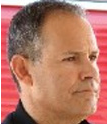After nearly a year of vituperation and criticism from a portion of the community, Upland fire chief Michael Antonucci has departed the city for good.
Antonucci was forced into retirement in September, but was given a $78,163 six-month contract to remain as chief while his successor was sought.
Beginning last April, a campaign aimed at convincing the Upland City Council to terminate Antonucci was waged by a coterie of residents and former and current department employees. Many of the attacks on the chief manifested in the form of anonymous emails posted to the city council.
Antonucci was taken to task on a number of points, including allegations he had disciplined, fired or punished some department employees unjustifiably, promoted or kept in place unqualified personnel, and squandered money made available to the city from both the federal government and Lewis Operating Company on equipment that has been deployed in a way that endangers rather than enhances citizen safety.
One issue Antonucci was chastised for was the decision to purchase two vehicles for the department: a ladder truck and a Type IV engine.
The $1.5 million ladder truck was purchased with development fees paid to the city by Lewis Operating Company, the corporate parent to Lewis Homes, one of the city’s largest corporations and also one of the major builders of residential and commercial property in town.
The ladder truck is the capital engine at Fire Station 164, the city’s newest fire station, located at 1825 N. Campus Avenue. The ladder truck, which allows firefighters to access and exit from heights up to four stories, carries no fire suppression equipment, i.e., no water pump and no water tank. This use of the $1.5 million vehicle was questioned because as the primary first response piece of equipment run out of Station #164, which services the northeast portion of Upland, critics maintained, immediate fire suppression in that section of the city would be delayed because no pump truck is stationed at Station #164.
The $170,000 Type IV engine was purchased with a combination of redevelopment funds, Community Development Block grants and federal stimulus and recovery money. The engine had gone unmanned at Station 162, on San Antonio Ave., in the northern area of the city. The placement of the truck into that area has been criticized because Community Development Block grant funding of a project carries with it a requirement that the program benefit an area deemed a so-called CDBG fund area. The area served by Station 162 is not designated as a CDBG fund area.
While Antonucci, at the insistence of Upland’s city attorney Bill Curley, remained silent in the face of those attacks, other Upland municipal officials downplayed the charges, insisting that Antonucci was apportioning the city’s firefighting resources as sensibly as the limitations in equipment, facilities and manpower allowed.
Upland city manager Stephen Dunn pointed out that the ladder truck carries 500 gallons of foam and 60 gallons of water to make up to 1,200 gallons of air injected foam, which in the fire department’s estimation was more than enough for initial response, and the truck had the capability of tapping into the fire hydrants in most areas of the city and all of the fire hydrants in the Station 164 area, which Dunn said would buy sufficient time for a second response truck to arrive. Dunn defended the acquisition and use of the ladder truck, saying having a panoply of equipment and vehicles in a modern municipal circumstance enhanced public safety and did not harm it.
“In Upland there are not a whole lot but there are some buildings where a ladder truck would be advantageous and a better option than other trucks, which are advantageous in other scenarios,” Dunn said.
Antonucci was also criticized for having spent money extravagantly in outfitting Station #164 with granite counter-tops and full granite back-splashes and stainless steel appliances, and he came under attack for having the department purchase a command vehicle that could not be justified in terms of the austere budgetary climate and the simple mission of ensuring public safety.
In the spring of last year, even as the attacks against him were reaching a crescendo, Antonucci applied for the position of county fire chief but was ultimately passed over in favor of Mark Hartwig, an assistant chief then employed by the Rancho Cucamonga Fire Department.
Ultimately, Dunn resolved to winnow the city of much of its executive staff, including Antonucci, who was being paid a base salary and add-ons of $170,698, plus benefits of $71,692 for a total of $242,390 yearly. But no new fire chief was hired to replace him and before Antonucci left in September, he was permitted to write his own ticket as a consultant at $13,027.16 per month while the city sought to recruit his replacement. This led to stepped up criticism of the city.
It was announced this week that police chief Jeff Mendenhall will serve as interim fire chief in the aftermath of Antonucci’s departure.
Dunn’s move to place the police chief into that position broaches the possibility of the city eliminating the position of fire chief altogether and consolidating the police and fire chief positions into the single post of public safety manager, which was a system used in the city of Arcadia until 1936 and currently in Grants Pass, Oregon.
There is some precedent for this arrangement in Upland. In the 1990s, then-police chief Martin Thouvenell served as both police and fire chief for almost six years.

